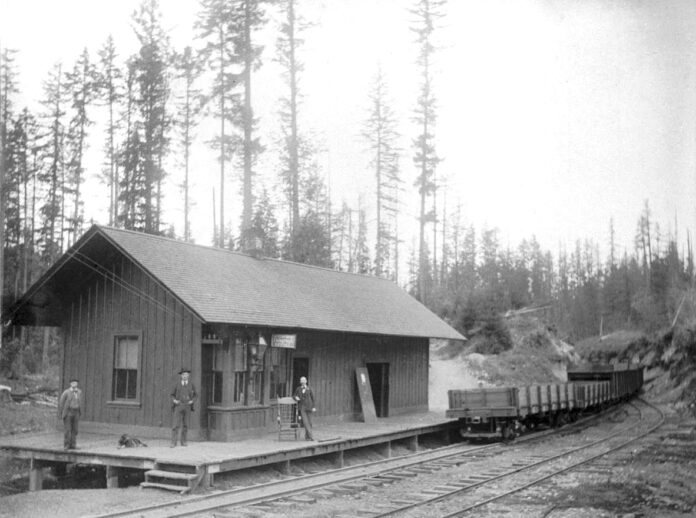New residents to the area may be surprised to learn that Maple Valley once supported a railroad station. Construction of the first station between a bend in Taylor Creek and the Cedar River fixed the trading center of Maple Valley in the 1880s. In fact, three separate depot buildings were constructed within the small commercial area near where S.R. 18 passes over Highway 169. Ironically today, that area isn’t even within Maple Valley city limits.
This first station was located near S.E. 216th and across the highway from the old Maple Valley Market (now vacant) and the Shell station. This 1891 image of that depot station comes courtesy of Gary Gibbon. Standing on the platform from left to right are his grandfather, W.D. Gibbon, Sam Huth, and Station Agent, Hanagen.
Why the railroad came through Maple Valley had everything to do with the discovery of coal near Black Diamond in 1880. Two years later, the Columbia & Puget Sound Railroad was induced by the Black Diamond Coal Mining Company to construct a rail line up the Cedar River from Renton through Maple Valley then passing by Lake Wilderness and Four Corners. The Oregon Improvement Company was preparing to open coal mines in Franklin, so the line was extended two miles further east to the Green River Gorge. By 1892, a new 10-mile line to the east was completed to Taylor passing through Hobart along the way. The Black Diamond and Taylor lines joined near the site of this Maple Valley rail depot.
A Seattle Daily Intelligencer article from May 15, 1890 heralded the new Columbia & Puget Sound facilities and noted that a telegraph operator and ticket agent would be appointed to the station. Passenger service was available between Black Diamond and Seattle, as well as the more established Newcastle coal mines, also served by the Columbia & Puget Sound Railroad.
Coal declined in importance following the discovery of oil in California and the development of cheap electricity from dams along the Columbia River. Rail service to Black Diamond ceased in 1970. Maple Valley saw the final train pass through in 1980 with tracks and ties removed shortly after. Most of the rights-of-way were acquired by King County Parks and today support the Cedar River Trail.








